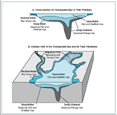|
Click on photo to view larger image



|
Since 1987, the Chesapeake Bay Program partners (Maryland, Virginia, Pennsylvania, and the District of Columbia) have been working to reduce nutrient loading levels, and improve the Bay’s low dissolved oxygen (DO) conditions. To this end, nitrogen and phosphorus caps have been set for each major Chesapeake Bay tributary basin.
The new Chesapeake Bay water quality standards were developed from a realization that, because of a layering effect called stratification, the current effect-based nutrient criteria of 5 milligrams per liter (mg/L) has never been fully attainable. This is especially true in certain deep areas of the Bay during summer periods. Since these criteria could not have been met even in the time of John Smith’s exploration of the Bay, Maryland is proposing to change it. The new requirement will reflect not only the bottom water conditions, but to also set higher criteria for fish nursery and spawning areas during critical spring months.
MDE uses water quality standards to assure that state waterways are useable
for drinking water, swimming, fishing, as well as industrial and agricultural
purposes. New water quality standards will be used by permit writers to regulate
what individuals, businesses or farms may discharge into waterways.
To assist the states and the District of Columbia in adopting new water quality
standards, the Environmental Protection Agency’s Chesapeake Bay Program has
developed Regional Criteria Guidance. This document proposed five new designated
uses for the Chesapeake Bay. They are:
- migratory fish spawning and nursery,
- shallow water,
- open water fish and shellfish,
- deep water seasonal fish and shellfish,
- deep channel seasonal refuge.
Additionally, the Bay Program proposed complex water quality criteria (for dissolved oxygen, water clarity, and chlorophyll a) supporting the new designated uses. These criteria are tailored to the plants and animals that are adapted to life in the respective areas, rather than continuing to treat the Bay as a uniform ecosystem. The Bay Program completed the development of the Regional Criteria in 2003. However, this document serves only as guidance and will not become enforceable until it is adopted into state and district standards.
“The main goal of the newly re-proposed Maryland water quality standards for the Chesapeake Bay is to set realistic, protective, and scientifically defensible criteria to adequately manage and protect the Bay from effects of nutrient pollution and sedimentation,” said Kendl P. Philbrick, MDE secretary. “Most importantly, the new standards take into consideration particular needs of the Bay’s living resources.”
Moving Forward… Adopting Maryland Water Quality Standards
By spring of 2004, MDE began an initial round of reviews of the new Maryland water quality standards for the Bay. This included reviews by Maryland’s interagency Bay workgroup, EPA Chesapeake Bay Program, the Chesapeake Bay partners, and EPA Region III. The initial proposal was published in the Maryland Register in two parts followed by significant comments from the public and stakeholders. Based on these comments the department made revisions and re-proposed the standards on June 24. Public hearings for this re-proposal were held in Baltimore July 11 and comments were accepted through July 25. The official adoption notice is anticipated to be published in August.
The new Maryland water quality standards for the Bay consist of a classification of designated uses, and water quality criteria to protect these uses. A designated use refers to a water body's primary function – such as fishing or swimming – and takes into account the use of the water body for public water supply, the protection of fish, shellfish and wildlife, as well as its recreational, agricultural, industrial and navigational purposes. The designated uses are protected by water quality criteria, which quantify the allowable water pollutant or water quality parameter or identify a so-called free-from condition (e.g. waters shall be free from floating debris).
During the re-proposal process MDE addressed irreversible human activities issues. Because these issues cannot be currently rectified, restoration variances for two mainstem areas were established. This process will maintain the designated use of a waterbody, while allowing some exceedance of the criteria. The variance is temporary and will be periodically reviewed.
“The new standards will allow for a more precise assessment of living resource needs so that appropriate controls can be implemented, thus bringing Maryland closer to meeting the goals of the Chesapeake 2000 Agreement,” said Richard Eskin, Director of the Technical and Regulatory Services Administration at MDE.
For more information and the text of the proposed and re-proposed Bay water quality standards visit: www.mde.state.md.us/ResearchCenter/Data/ waterQualityStandards/, OR Maryland Register (Official Re-proposal)
www.dsd.state.md.us/mdregister/3213/main_register.htm
|